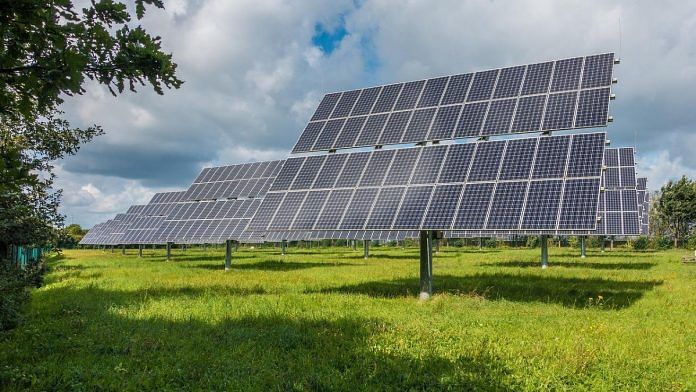New Delhi: Changing climate patterns over the next 50 years are likely to reduce the generation of solar power in India and affect the major wind power plants in certain regions, says a study by the Indian Institute of Tropical Meteorology (IITM), Pune.
Published in the journal Current Science last month, the study, Analysis of future wind and solar potential over India using climate models, suggests that the renewable energy sector should work on improving the efficiency of solar farms given that radiation is likely to dip by 10 to 15 watts per square metre (sqm) across all seasons.
Seasonal and annual wind speed is likely to decrease over north India and increase along south India, it adds.
The team took into account future climate projections across the globe as predicted by three internationally accepted prediction models — CORDEX-SA, CMIP5, and CMIP6 — to analyse solar and wind potential in India. Each of the models comprises historical climate data, which are used to predict future trends.
“We have tried to show the difference between historical climates and the future scenario. All the models show an overall decrease in wind and solar power generation potential in India,” Parthasarathi Mukhopadhyay, a scientist at IITM, told ThePrint. “Every model has its own uncertainty, but we have used three sets of models to analyse solar and wind potential over the peninsular region.”
Two climate scenarios — scientifically referred to as RCP 8.5 and RCP 4.5 — were considered for the study.
The first scenario envisages a high-emission situation when there is no concerted effort to cut greenhouse gas emissions. The other is an intermediate scenario where emissions start declining by 2040.
The researchers divided the country into seven regions — the Gangetic plains, eastern, south-eastern, south, western, north-western and central India — for individual analysis.
“In some regions such as western India, all three models show both wind and solar potential are decreasing,” Mukhopadhyay said, adding that all the models showing similar results increases confidence in them.
How deficit can be overcome
Keeping in mind the changing pattern in solar radiation, the study suggests central and south-central India must be considered for the sector during pre-monsoon months, as the potential loss was minimum in these regions
“North-western India — the biggest solar energy hub — is likely to see a loss in its energy capacity,” Mukhopadhyay said. “With increasing pollution levels, there will be an increase in aerosols in the environment. This, in turn, increases the cloud lifetime. As a result, the cloud cover is sustained for a long time, which means that solar radiation will be reduced.”
As for the changes in wind patterns, the study says global warming would result in a drop in wind potential in some regions, and a rise in others.
Even a slight change in wind movement matters as its power increases with the cube of the speed, i.e., doubling the speed gives eight times the wind power.
While wind potential over onshore regions shows an increasing trend for the non-monsoon months, it was reversed in offshore regions. A seasonal analysis also indicated India’s southern and north-western regions having higher wind speeds in winter and monsoon months, the study says.
Likewise, a regional analysis indicated that the frequency of high energy-producing winds will decrease, whereas low-speed winds were likely to increase in the future.
The analysis found that wind speed would increase in the Gangetic plains and decrease along the western coast of India. While there would be little change in eastern and southeastern parts of India, a reduction in wind speed was likely in eastern offshore regions.
“The southern coast of Odisha and the southern states of Andhra Pradesh and Tamil Nadu show promising potential for wind energy in the climate change scenario,” says the study.
Given that both solar and wind potential in India were likely to face a negative trend, the researchers predicted that the deficits could be overcome by including more farms and using highly efficient power generators than those available at present.
(Edited by Tony Rai)
Also Read: Fossil fuel subsidy 9 times higher than for clean energy, says study on India’s net-zero goal



